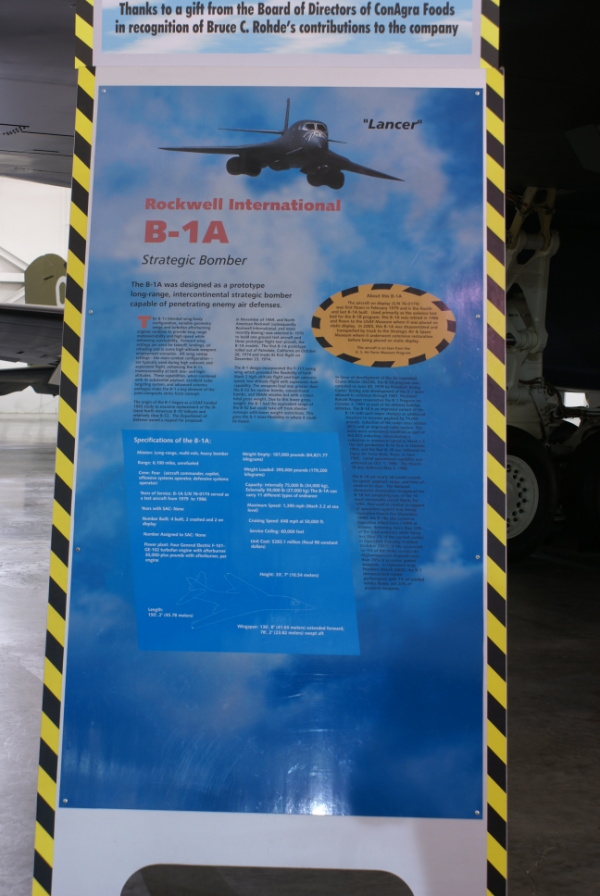| Prev |
heroicrelics.org Strategic Air Command & Aerospace Museum Site Index B-1A Gallery |
Next |
dsc60582.jpg
The sign accompanying the aircraft. It reads
"Lancer"
Rockwell International
B-1A
Strategic BomberThe B-1A was designed as a prototype long-range, intercontinental strategic bomber capable of penetrating enemy air defenses.
The B-1's blended wing/body configuration, variable-geometry wings and turbofan afterburning engines combine to provide long range maneuverability and high speed while enhancing survivability. Forward wing settings are used for takeoff, landings, air refueling and in some high-altitude weapons employment scenarios. Aft wing sweep settings - the main combat configuration - are typically used during high subsonic and supersonic flight, enhancing the B-1's maneuverability at both low and high altitudes. These capabilities, when combined with its substantial payload, excellent radar targeting system, and advanced avionics packages make the B-1 a key element of the joint/composite strike force concept.
The origin of the B-1 began as a USAF funded 1965 study to examine replacement of the ill-fated North American B-70 Valkyrie and relatively slow B-52. The Department of Defense issued a request for proposals in November of 1969, and North American Rockwell (subsequently Rockwell International, and more recently Boeing) was selected in 1970 to build one ground test aircraft and three prototype flight test aircraft, the B-1A models. The first B-1A prototype rolled out of Palmdale, California on October 26, 1974 and made its first flight on December 23, 1974.
The B-1 design incorporated the F-111 swing wing which provided the flexibility of both Mach 2 high-altitude flight and high subsonic speed, low altitude flight with supersonic dash capability. The weapons load was greater than the B-52 for nuclear bombs, conventional bombs, and SRAM missiles but with a lower total gross weight. Due to this lower gross weight, the B-1 had the equivalent range of the B-52 but could take-off from shorter runways with lower weight restrictions. This gave the B-1 more flexibility in where it could be based.
In favor of development of the Air Launched Cruise Missile (ALCM), the B-1A program was canceled on June 30, 1977 by President Jimmy Carter. Testing and development of the B-1 were allowed to continue through 1981. President Ronald Reagan resurrected the B-1 program on October 2, 1981 as part of his defense buildup initiative. The B-1B is an improved variant of the B-1A with such major changes as additional structure to increase payload by 74,000 pounds, reduction of the radar cross section (RCS) and an improved radar system. The inlets were extensively modified as part of this RCS reduction, necessitating a reduction in maximum speed to Mach 1.2. The first production B-1B flew in October 1984, and the first B-1B was delivered to Dyess Air Force Base, Texas, in June 1985. Initial operational capability was achieved on Oct. 1, 1986. The final B-1B was delivered May 2, 1988.
The B-1B set nearly 50 world records for speed, payload, range, and time-of-climb in its class. The National Aeronautic Association recognized the B-1B for completing one of the 10 most memorable record flights for 1994. First used in combat in support of operations against Iraq during Operation Desert Fox (December 1998), the B-1Bs also served in Operation Allied Force (1999) in Kosovo, delivering more than 20% of the total ordnance while flying less than 2% of the combat sorties. In Operation Enduring Freedom (October 2001), the B-1Bs accounted for 5% of the strike sorties into Afghanistan and dropped more than 70% of precision guided weapons. In Operation Iraqi Freedom (March 2003), the B-1 demonstrated similar performance with 1% of combat sorties flown, yet 22% of precision weapons.
About This B-1A
The aircraft on display (S/N 76-0174) was first flown in February 1979 and is the fourth and last B-1A build. Used primarily as the avionics test bed for the B-1B program, this B-1A was retired in 1986 and flown to the USAF Museum where it was placed on static display. In 2003, this B-1A was disassembled and transported by truck to the Strategic Air & Space Museum where it underwent extensive restoration before being placed on static display.
This aircraft is on loan from the U.S. Air Force Museum Program.
Specifications of the B-1A
Mission: Long-range, multi-role, heavy bomber
Range: 6,100 miles, unrefueled
Crew: Four (aircraft commander, copilot, offensive systems operator, defensive systems operator)
Years of service: B-1A S/N 76-0174 served as a test aircraft from 1979 to 1986
Years with SAC: None
Number built: 4 built, 2 crashed and 2 on display
Number assigned to SAC: None
Power Plant: Four General Electric F-101-GE-102 turbofan engines with afterburner 30,000-plus pounds with afterburner, per engine
Weight, empty: 187,000 pounds (84,821.77 kilograms)
Weight, loaded: 395,000 pounds (179,200 kilograms)
Capacity: Internally 75,000 lb (34,000 kt). Externally 59,000 lb (27,000kt). The B-1A can carry 11 different types of ordnance
Maximum speed: 1,390 mph (Mach 2.2 at sea level)
Cruising speed: 648 mph at 50,000 ft.
Service ceiling: 60,000 feet
Unit Cost: $283.1 million (fiscal 98 constant dollars)
Height: 33', 7" (10.54 meters)
Length: 150', 2" (45.78 meters)
Wingspan: 136', 8" (41.65 meters) extended forward; 78' 2" (23.82 meters) swept aft

| Time picture taken | Fri Apr 17 12:28:18 2009 |
| Location picture taken |
Hangar B Strategic Air & Space Museum Ashland, NE |
| Prev |
heroicrelics.org Strategic Air Command & Aerospace Museum Site Index B-1A Gallery |
Next |